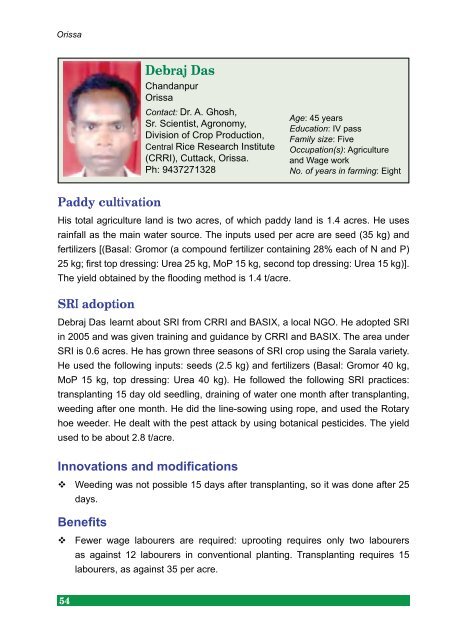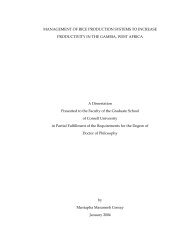Experiences of Farmers in India Experiences of Farmers in ... - AgSri
Experiences of Farmers in India Experiences of Farmers in ... - AgSri
Experiences of Farmers in India Experiences of Farmers in ... - AgSri
You also want an ePaper? Increase the reach of your titles
YUMPU automatically turns print PDFs into web optimized ePapers that Google loves.
Orissa<br />
Paddy cultivation<br />
54<br />
Debraj Das<br />
Chandanpur<br />
Orissa<br />
Contact: Dr. A. Ghosh,<br />
Sr. Scientist, Agronomy,<br />
Division <strong>of</strong> Crop Production,<br />
Central Rice Research Institute<br />
(CRRI), Cuttack, Orissa.<br />
Ph: 9437271328<br />
Age: 45 years<br />
Education: IV pass<br />
Family size: Five<br />
Occupation(s): Agriculture<br />
and Wage work<br />
No. <strong>of</strong> years <strong>in</strong> farm<strong>in</strong>g: Eight<br />
His total agriculture land is two acres, <strong>of</strong> which paddy land is 1.4 acres. He uses<br />
ra<strong>in</strong>fall as the ma<strong>in</strong> water source. The <strong>in</strong>puts used per acre are seed (35 kg) and<br />
fertilizers [(Basal: Gromor (a compound fertilizer conta<strong>in</strong><strong>in</strong>g 28% each <strong>of</strong> N and P)<br />
25 kg; first top dress<strong>in</strong>g: Urea 25 kg, MoP 15 kg, second top dress<strong>in</strong>g: Urea 15 kg)].<br />
The yield obta<strong>in</strong>ed by the flood<strong>in</strong>g method is 1.4 t/acre.<br />
SRI adoption<br />
Debraj Das learnt about SRI from CRRI and BASIX, a local NGO. He adopted SRI<br />
<strong>in</strong> 2005 and was given tra<strong>in</strong><strong>in</strong>g and guidance by CRRI and BASIX. The area under<br />
SRI is 0.6 acres. He has grown three seasons <strong>of</strong> SRI crop us<strong>in</strong>g the Sarala variety.<br />
He used the follow<strong>in</strong>g <strong>in</strong>puts: seeds (2.5 kg) and fertilizers (Basal: Gromor 40 kg,<br />
MoP 15 kg, top dress<strong>in</strong>g: Urea 40 kg). He followed the follow<strong>in</strong>g SRI practices:<br />
transplant<strong>in</strong>g 15 day old seedl<strong>in</strong>g, dra<strong>in</strong><strong>in</strong>g <strong>of</strong> water one month after transplant<strong>in</strong>g,<br />
weed<strong>in</strong>g after one month. He did the l<strong>in</strong>e-sow<strong>in</strong>g us<strong>in</strong>g rope, and used the Rotary<br />
hoe weeder. He dealt with the pest attack by us<strong>in</strong>g botanical pesticides. The yield<br />
used to be about 2.8 t/acre.<br />
Innovations and modifications<br />
Weed<strong>in</strong>g was not possible 15 days after transplant<strong>in</strong>g, so it was done after 25<br />
days.<br />
Benefits<br />
Fewer wage labourers are required: uproot<strong>in</strong>g requires only two labourers<br />
as aga<strong>in</strong>st 12 labourers <strong>in</strong> conventional plant<strong>in</strong>g. Transplant<strong>in</strong>g requires 15<br />
labourers, as aga<strong>in</strong>st 35 per acre.
















